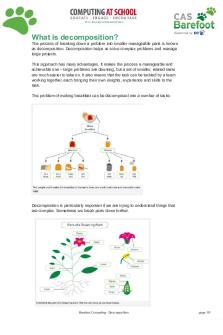Spectral decomposition PDF

| Title | Spectral decomposition |
|---|---|
| Course | Classical and Quantum Mechanics |
| Institution | University of Hull |
| Pages | 2 |
| File Size | 99.1 KB |
| File Type | |
| Total Downloads | 41 |
| Total Views | 148 |
Summary
Quantum 5...
Description
Concepts Completeness (closure) relation A sum of projection operators is a sum of outer products, and thus can effectively “generate” elaborate operators. For example, let’s take a 3-dimensional vector space and construct a sum of projectors using three orthogonal states, 1, 2, and 3 in this vector space. These are labels for the states, not numbers themselves. They could be ψ1, ψ 2 and ψ3, or 𝑥,𝑦 and 𝑧… but we’ll stick with numbers for now. 0 |𝑠〉〈𝑠|
= |1〉〈1| + |2〉〈2| + |3〉〈3|
!
This sum of three projectors thus spans all possible basis states (or dimensions) in the given 3-dimensional vector space. If a sum of projector has enough terms to map all dimensions, it can be said to be complete, and effectively becomes the identity operator in that vector space. The identity operator, 𝐼6, is one that doesn’t change the function/state that it’s applied to – the matrix/vector equivalent of multiplying by 1. In maths terms, you can write this as: 𝐼6|𝜓〉 = 0|𝑠〉〈𝑠|𝜓〉8
= |1〉〈1|𝜓〉 + |2〉〈2|𝜓〉 + |3〉〈3|𝜓〉 = |𝜓〉
!
Relevance… This can help us tidy up some awkward bits of notation. For instance, the following expression with two operators 𝐴6 and 𝐵& is hard to compute because it requires multiplying two operators and the order to do it becomes ambiguous. 〈𝑟|𝐴6𝐵&|𝑐〉 So we can insert the identity operator into the middle without changing anything, replace it with a sum of projectors. A truly complete set of projectors might require an infinite sum, but if the sum has just enough projectors to describe the system properly, we can speed this calculation up: 〈𝑟|𝐴6𝐼6𝐵&|𝑐〉 = 0〈𝑟|𝐴6|𝑠〉〈𝑠|𝐵& |𝑐〉 !
Things like 〈𝑟|𝐴6|𝑠〉 and 〈𝑠|𝐵& |𝑐〉 are much easier to work with and can be multiplied in any order.
Spectral Decomposition Theorem The spectral decomposition theorem says that if we know all the eigenfunctions of an operator, we can rebuild it using a set of projectors. So if we know that 1, 2 and 3 are eigenvectors/eigenfunctions of the operator, we know that: 𝑂& |1〉 = 𝑎" |1〉
& |2〉 = 𝑎# |2〉 𝑂
& , can be described as: So the operator, 𝑂
& |3〉 = 𝑎$ |3〉 𝑂
𝑂& = 0| 𝑠〉 〈𝑠| = 𝑎"|1〉〈1 | + 𝑎# |2〉〈2 | + 𝑎$ |3〉〈3| !
Where 𝑎! are the eigenvalues, these are just numbers. So we can insert the above into any of the three eigenfunction equations. 𝑂& |1〉 = 0| 𝑠〉〈𝑠|1〉 = 𝑎" |1〉〈1|1〉 + 𝑎# |2〉〈2|1〉 + 𝑎$|3〉〈3|1〉 = 𝑎"|1〉 !
Remember that 〈 𝑥 ∣ 𝑥 〉 = 1 but 〈 𝑥 ∣ 𝑦 〉 = 0. A lot of the manipulation of these formulas is all about trying to get everything to look like these bras and kets, and finding which ones equal 1 and which ones equal 0.
Idempotent operators Projectors are idempotent operators, which means that squaring (cubing, etc..) them has no effect on them. In other words: &$ = ⋯ = 𝒫 &% 𝒫& = 𝒫& # = 𝒫
This is easily verified using for example a projector on normalised state |1⟩, i.e. 𝒫&" = |1〉〈 1|: &"# = B𝒫&" C# = 𝒫 &" 𝒫 &" = |1〉〈1|1⟩〈 1| = |1〉〈1| = 𝒫&" 𝒫
&". as 〈 1|1⟩ = 1. It is straightforward to show the same applies for other powers of 𝒫...
Similar Free PDFs

Spectral decomposition
- 2 Pages

Modal and spectral matrices
- 9 Pages

Decomposition potential
- 4 Pages

Lecture 10 -Decomposition
- 1 Pages

Lecture 4 - Classical Decomposition
- 24 Pages

Decomposition of Tables in dbms
- 1 Pages
Popular Institutions
- Tinajero National High School - Annex
- Politeknik Caltex Riau
- Yokohama City University
- SGT University
- University of Al-Qadisiyah
- Divine Word College of Vigan
- Techniek College Rotterdam
- Universidade de Santiago
- Universiti Teknologi MARA Cawangan Johor Kampus Pasir Gudang
- Poltekkes Kemenkes Yogyakarta
- Baguio City National High School
- Colegio san marcos
- preparatoria uno
- Centro de Bachillerato Tecnológico Industrial y de Servicios No. 107
- Dalian Maritime University
- Quang Trung Secondary School
- Colegio Tecnológico en Informática
- Corporación Regional de Educación Superior
- Grupo CEDVA
- Dar Al Uloom University
- Centro de Estudios Preuniversitarios de la Universidad Nacional de Ingeniería
- 上智大学
- Aakash International School, Nuna Majara
- San Felipe Neri Catholic School
- Kang Chiao International School - New Taipei City
- Misamis Occidental National High School
- Institución Educativa Escuela Normal Juan Ladrilleros
- Kolehiyo ng Pantukan
- Batanes State College
- Instituto Continental
- Sekolah Menengah Kejuruan Kesehatan Kaltara (Tarakan)
- Colegio de La Inmaculada Concepcion - Cebu









